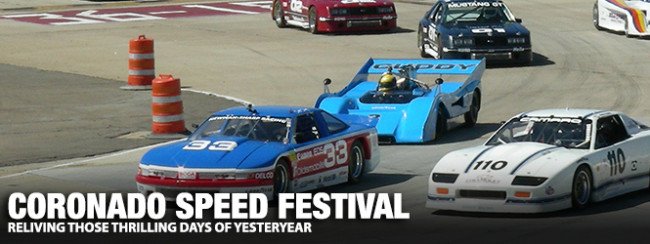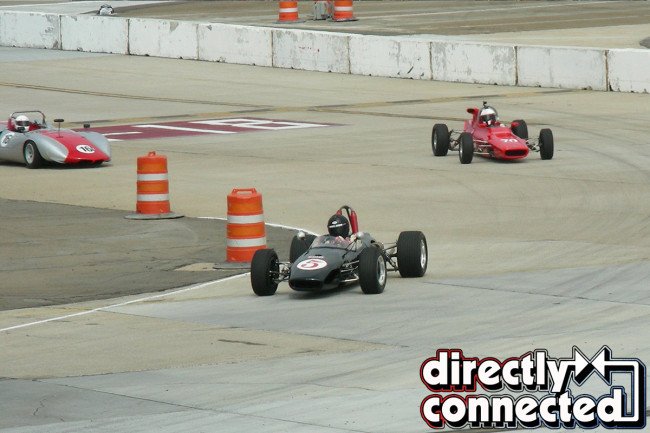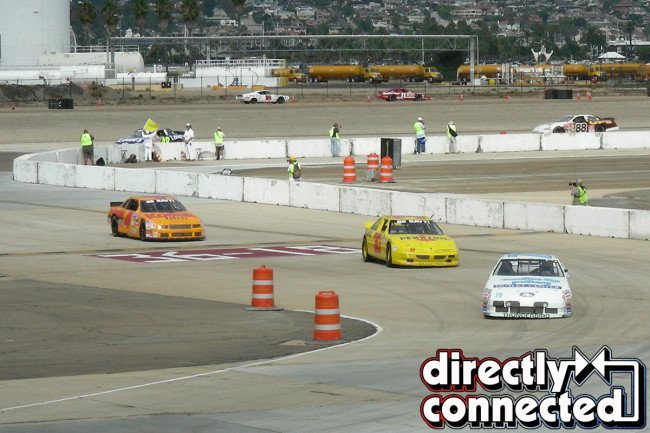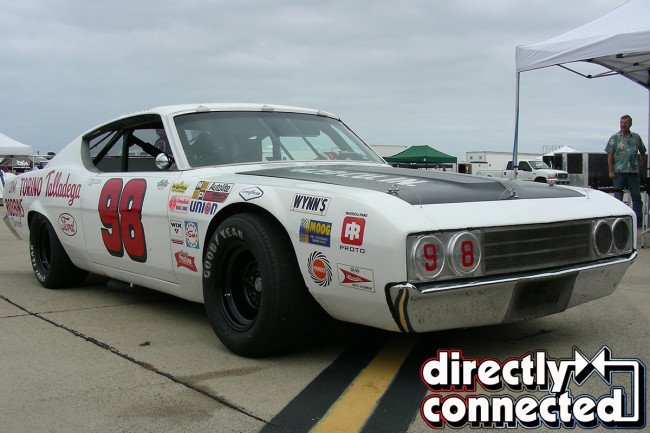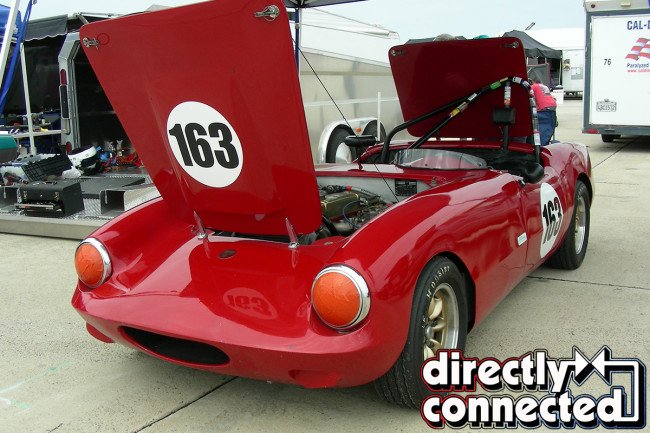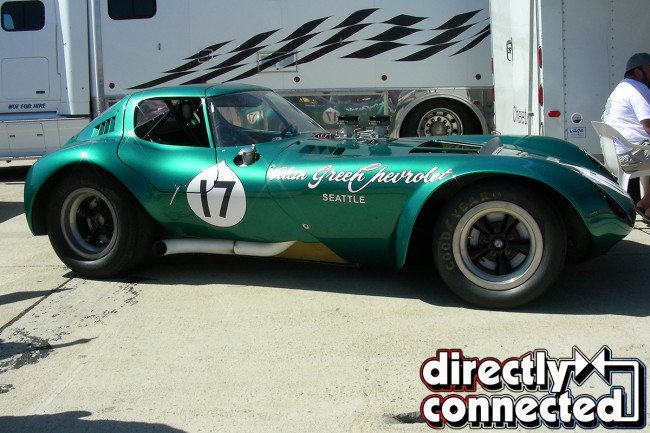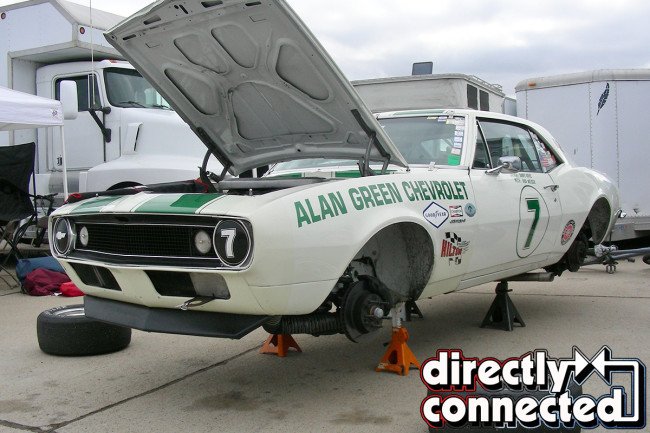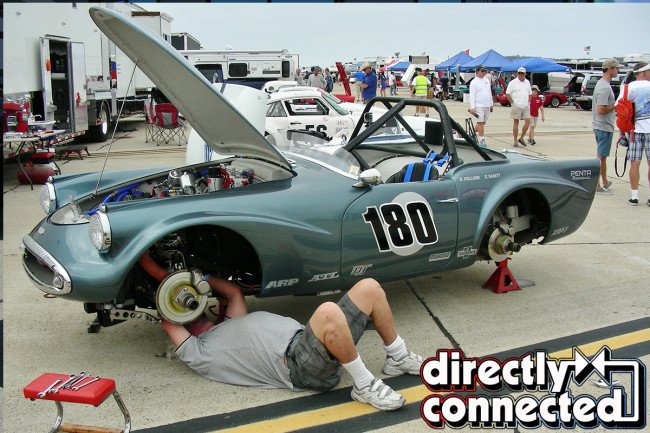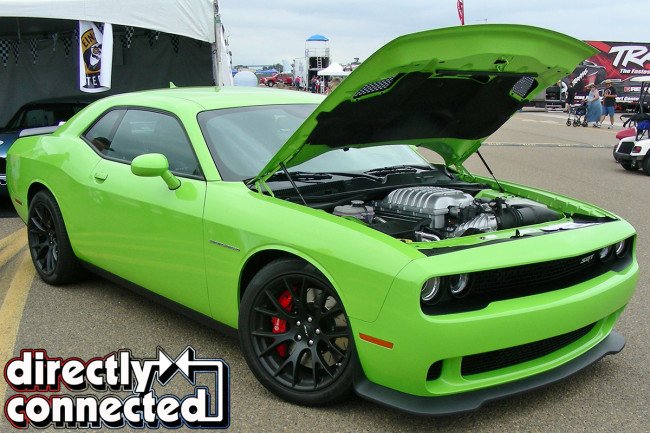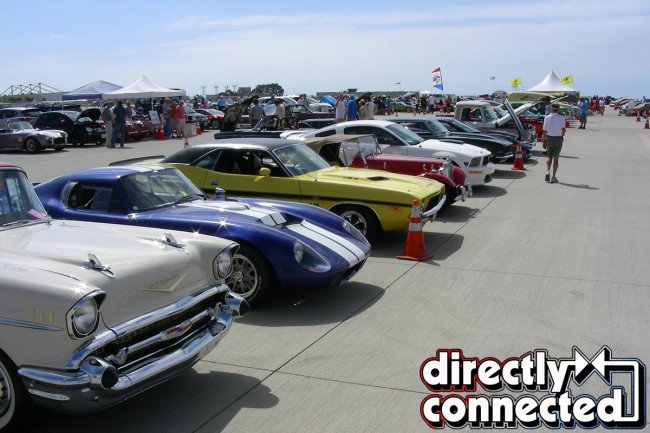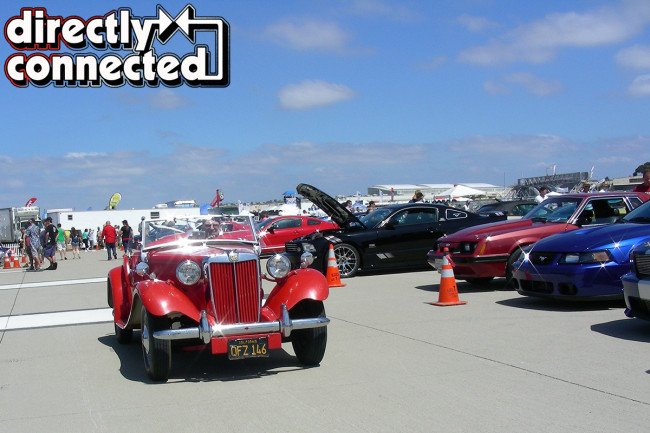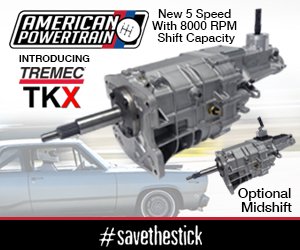Road Racing. Just the name conjures up images of brightly colored sports cars broad sliding around corners and charging down narrow, tree lined straightaways at high speed. The excitement is palpable among the crowd of onlookers as the cars pass in a blur; the stillness of the air shattered by the staccato sounds of engines running at wide open throttle, as each driver bravely charges forward in the pursuit of victory.
Prior to World War II, road racing was largely a European automotive sport. The races were held on courses that often included sections of public roadways, and many ran over long distances. Each country held events that fiercely stoked nationalist pride, such as the Targa Florio in Italy, the Nurburgring in Germany, Le Mans in France and the Tourist Trophy in Great Britain. In most cases, the vehicles were painted in the colors that represented their country; red for Italy, silver for Germany, blue for France and green for Great Britain. Much like the Palio in Italy, where riders representing different wards in Sienna raced horses against each other around the square in an effort to uphold the honor of their neighborhood, in road racing, most teams raced to win for the pride and glory of their country.
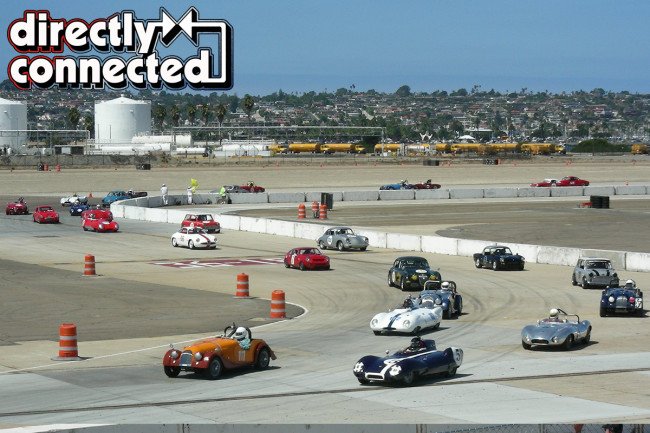
Above left: Group Four was comprised of 1965 – 1968 FIA Manufacturers Championship Cars. These cars were brutally fast and many were powered by big inch V8s or turbo charged sixes. They included Lolas, McLarens, Ferraris, Porsches, Camaros and Mustangs, just to name a few. Above right: Chevron number 73 leading several cars through a right hander in Group Three Sports Racing and Formula Cars competition.
At the same time, it was quite different in the United States, where the majority of racing events were held on oval tracks. Most were small local dirt tracks, where competitors raced jalopies. The Indianapolis 500 was something of an exception, as it was held at a paved, first class racing facility where purpose built open wheel race cars were piloted by professional drivers. Other than an occasional car from a foreign country competing in the Indy 500, the fields were generally comprised of American cars that were painted every color in the rainbow with the sole goal of winning the race and achieving glory and the purse for the driver, owner and the sponsor.
All of that changed after WWII. GI’s returning home from Europe when the war ended bought back some of the small sports cars they fell in love with while they were stationed there. By the late 1940’s MG TC’s and Jaguar XK 120’s began showing up on our shores, forever changing the way many Americans looked at cars. These were alternatives to the large, softly sprung vehicles that dominated the market in this country. However, American ingenuity was not to be denied and in a short time, innovators like Briggs Cunningham and Frank Kurtis were creating lightweight, brutally fast, sports cars powered by the latest high compression Chrysler and Oldsmobile V8 engines to compete with the upstart imports.
Above left: Brabham BT 10 leads a Titan Mk6 into the corner in Group Seven Sports Racing Formula Cars under 2000cc. Above center: In the Group Eight Historic NASCAR event, the action was fast and furious. Entering the turn is a Ford Thunderbird, followed by a Pontiac Grand Prix and a Chevrolet Lumina. Look closely and you’ll also see a white 1969 Ford Torino Talladega blazing down the back straight. Above right: One of the highlights of the day for many people was the Group Nine 1966 to 1972 Historic Trans-AM races. A big field with lots of cars to root for, one of the red hot pony cars in competition was the number 6 Javelin that Mark Donohue raced to second place in the Tran-AM championship in 1970.
Above left: In the pits, we spotted the 1969 Ford Torino Talladega that was racing in the Group Eight Historic NASCAR event. Designed to compete with the 1969 Dodge Charger 500 and Daytona, it had a sinister, purposeful appearance. Above right: The original 1970 Javelin that Mark Donohue and Roger Penske campaigned in Trans-AM was being serviced between rounds. It was raced at the Coronado Speed Festival by Bruce Canepa and came in second place in practice on Saturday afternoon.
At the same time, sports car racing began to take hold here, and with no existing venues to compete at, air strips were often times used to hold events. This was well before tracks such as Road America in Elkhart Lake, Wisconsin were built. One of the most famous and longest lasting road racing events in America is held in Sebring, Florida. The races first began there in 1950, on the runways of a WWII Army Air Force training base where, just a few years earlier, pilots had learned how to fly B-17 Flying Fortresses. In a short time, the major event at this facility was the 12 Hours of Sebring endurance race, and as tracks began popping up all over the country, sports cars quickly gained popularity among enthusiasts.
Soon, automobile manufacturers took notice of this emerging trend and jumped into the fray, offering sports cars such as the Nash Healy, the Crosley Hotshot and the most famous of all, the Chevrolet Corvette in 1953. Meanwhile, the opportunity to sell sports cars in a prosperous post war America motivated many European manufacturers to export vehicles here. After recovering from the war, companies such as Porsche, Ferrari, Austin Healy and Alfa Romeo made inroads into the American market. The rest, as they say, is history.
Above left: This Elva Courier raced in Group Five Production Cars with Disc Brakes. Above right: Feeding the beast in the pits between rounds.
Above left: One of the original surviving Cheetah’s that were built by Bill Thomas, this one was originally campaigned by Alan Green Chevrolet in Seattle. Extremely lightweight, it was powered by a potent small block Chevy and designed to compete against the Cobras. Above center: Racing in the Trans-AM, this 1967 Camaro was also campaigned by Alan Green Chevrolet, a dealership that was very involved in road racing competition in the 1960’s. Above right: Gorgeous 1958 Devin SS competed in Group One Sports Racing and Production Cars. Powered by a small block Chevy, it was pristine and looked just as capable of winning a car show as a vintage sports car race.
Attending the 17th Annual Coronado Speed Festival conjured up memories of what it must have been like back in the early 1950’s at Sebring, when sports car racing was in its infancy. Racing at the Naval Air Station North Island in San Diego, sports cars of all kinds ran on the runways normally reserved for military aircraft, unlike today’s mega buck facilities. Temporary concrete barriers marked the path of the course, much like hay bales did in the 1950’s, and an incredible variety of vehicles were pitted against each other in wheel to wheel competition, which made for some really exciting racing.
On Saturday, there were two sets of qualifying sessions, one in the morning, followed by the second after lunch. On Sunday, there was one more practice session in the morning and in the afternoon it was all business, with the drivers competing in nine distinct groups for their chance to win in their category at this prestigious event. With the wide range of vehicle classes and the large number of race cars in competition, anyone who enjoyed watching the drivers go balls to the wall had the time of their life at the Coronado Speed Festival.
Above: Bill Elliot’s Dodge Intrepid was between rounds when we caught up with it in the pits alongside several other vintage NASCAR stock cars, like the ex- Sterling Marlin Coors Light sponsored Dodge.
Above left: This team was hard at work prepping a rarely seen 1962 Daimler SP 250 for the next round of competition. Above center: 1958 Lister Knobbly in bare aluminum looked and sounded absolutely ferocious. Running in Group One Sports Racing and Production Cars, it packed a potent V8 and was a force to be reckoned with on the track. Above right: While it looks like it could have been in competition, this Ford GT Mk 1 wore Gulf livery and was on display in the show area.
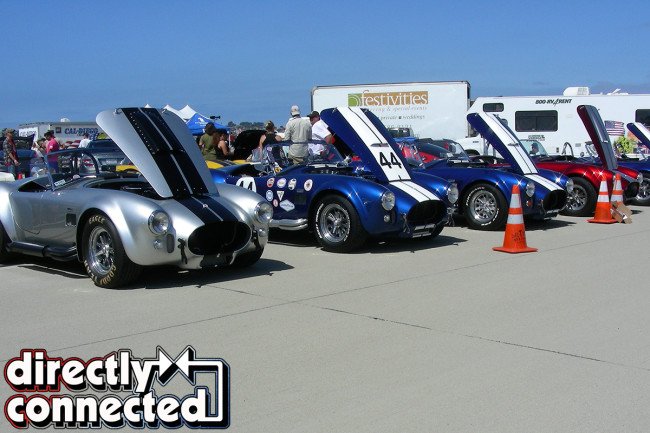
In addition to watching the racing, there was a large pit area for contestants that was open to the public, and it presented a great opportunity to get up close and personal with the cars when they were between sessions. Some were merely parked, others were being cleaned and then there were the ones that had been torn down for repairs in preparation for the next round of competition. The wide range of vehicles in competition provided a real potpourri that included open wheel Formula Cars, Production Sports Cars, Sports Racing Cars, Trans Am Cars and even NASCAR Stock Cars.
There were also vendor displays in the pits selling a wide range of parts, accessories and even turn-key cars. As Mopar enthusiasts, one of the displays that caught our eye in the pits was the San Diego Union Tribune tent, where the host of the Maynard’s Garage television program, Mark Maynard, had a brand spanking new Sublime 2015 Challenger Hellcat on display. The hood was up, the factory supercharged Hemi attracted plenty of attention from race fans, and Mark was constantly answering questions about the 707 horsepower supercar.
Above left: Sublime 2015 Dodge Challenger Hellcat was the subject of lots of attention all weekend in the San Diego Union Tribune Exhibit. Above right: Another green Mopar, this one a 1970 Challenger T/A was right at home at the Speed Festival.
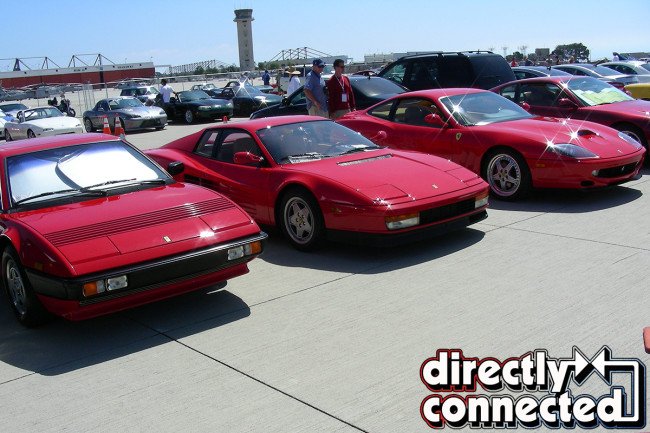
One of the interesting things about the Coronado Speed Festival, is that just like the Monterrey Historic Races, every vehicle in competition is real. To compete, the owner must prove the pedigree of the vehicle from its days in competition when it was new to race in this event. Needless to say, there were some really interesting survivors from an earlier time, when nearly all you needed to go club racing was to tape your headlights, put a number on your car and strap on a helmet.
In addition to the racing, there was large car show and club corral at the Coronado Speed Festival. Many clubs were represented, including those for Ferraris, Lamborghinis, Porches and Panteras. And since the Mustang was the Featured Marque of the event, it was only natural that there would be a large number of these pony cars on display, along with an equal number of both original and tribute Cobras. Interestingly, one of the best represented groups was the Mopar Club of San Diego, who displayed a wide variety of vintage and late model Dodges, Plymouths and Chryslers, plus several trucks, creating an interesting departure from the preponderance of the foreign cars at the show.
Above left: A wide range of vehicles of all types were on display in the club and show area. Above right: The MG TD driving down the aisle was restored to better than new condition.
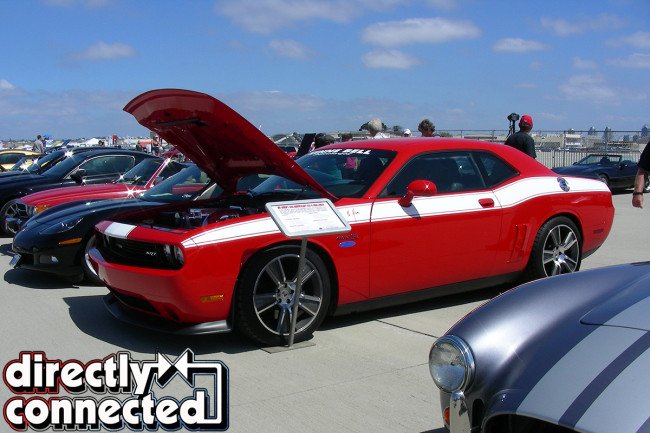
Another club that had a very interesting display was the Secret Car Club from Rancho Santa Fe, California. The vehicles ranged from Cobras and Mustangs, to Corvettes and Mercedes, along with a pre-war MG and several late model Fiat 500 Abarth’s. MoFans were also represented in the SCC exhibit thanks to the wicked TorRed Mr. Norm’s 50th Anniversary GSS-R 1000 horsepower Kenne Bell Supercharged Challenger. This car was seen on the cover of the January, 2014 issue of Pentastar Power and is a crowd pleaser at every event. The SCC even had a hospitality tent with food and beverages, making this one club display that attracted enthusiasts all weekend.
The Coronado Speed Festival is great fun. A big tip of the hat to the U.S. Navy for hosting this event, and making everyone feel at home at Naval Base Coronado. You can be sure that we’ll be back again next year, and if you are on the West Coast, we highly recommend that you consider attending this event. You’ll be glad you did!
“West Coast Report: The Coronado Speed Festival; Reliving Those Thrilling Days of Yesteryear” was originally written and photographed by Marv Herbert for PentaStar Power Magazine in October 2014.



